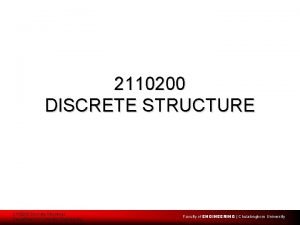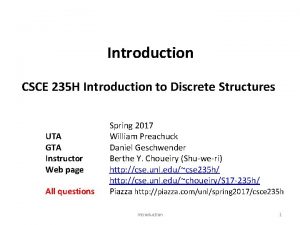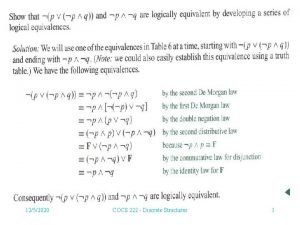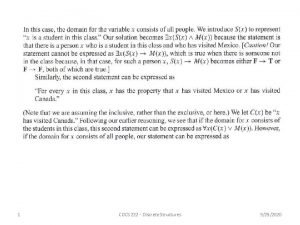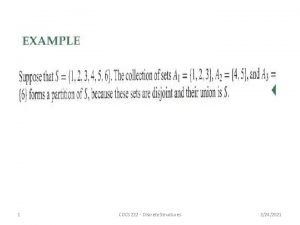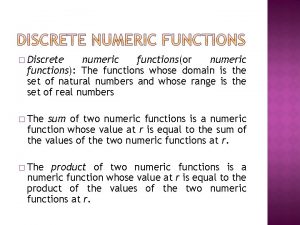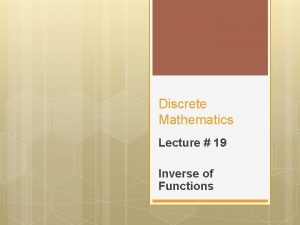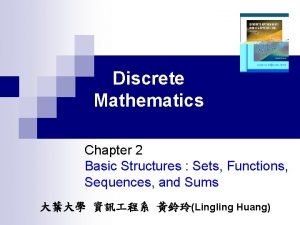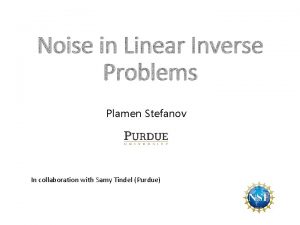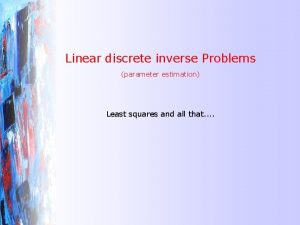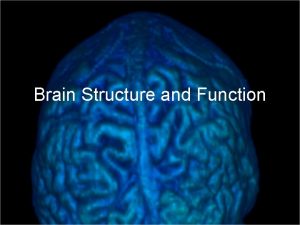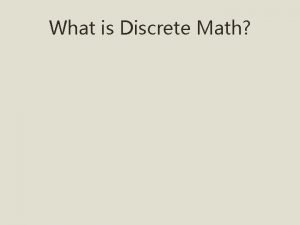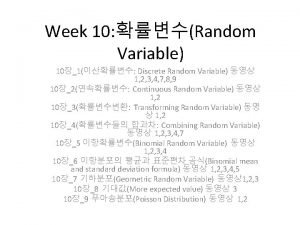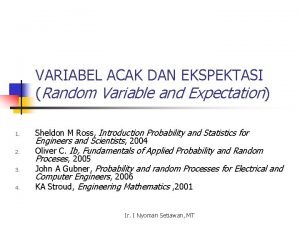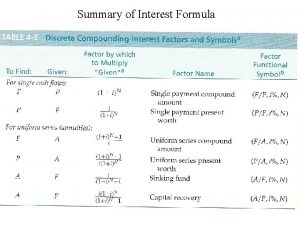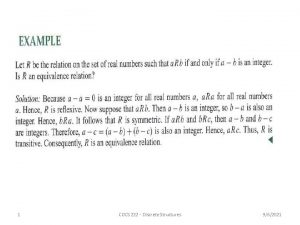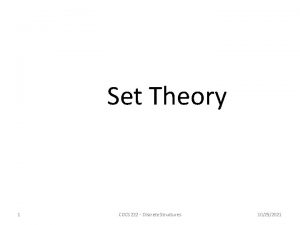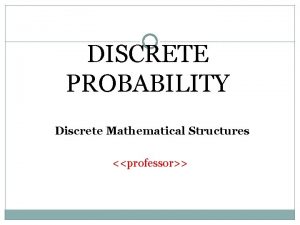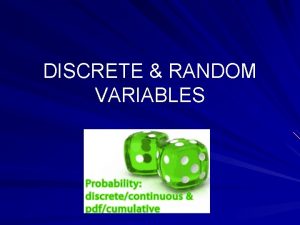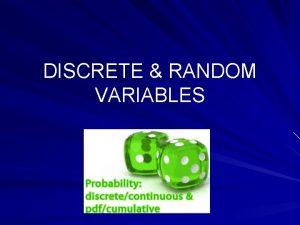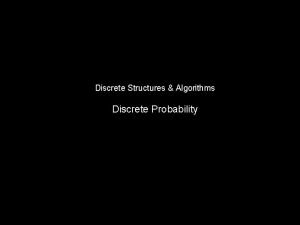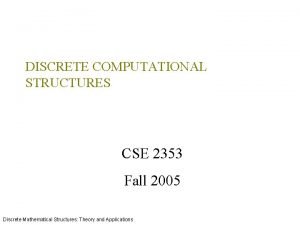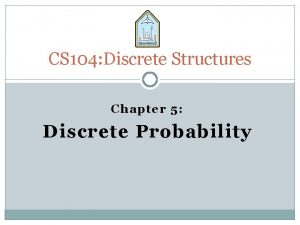Functions 6122021 COCS Discrete Structures 1 Functions A




























- Slides: 28

Functions 6/12/2021 COCS - Discrete Structures 1

Functions A function f from a set A to a set B is an assignment of exactly one element of B to each element of A. We write f(a) = b if b is the unique element of B assigned by the function f to the element a of A. If f is a function from A to B, we write f: A B (note: Here, “ “ has nothing to do with if… then) 6/12/2021 COCS - Discrete Structures 2

Functions If f: A B, we say that A is the domain of f and B is the codomain of f. If f(a) = b, we say that b is the image of a and a is the preimage of b. The range of f: A B is the set of all images of all elements of A. We say that f: A B maps A to B. 6/12/2021 COCS - Discrete Structures 3

Functions Let us take a look at the function f: P C with P = {Linda, Max, Kathy, Peter} C = {Boston, New York, Hong Kong, Moscow} f(Linda) = Moscow f(Max) = Boston f(Kathy) = Hong Kong f(Peter) = New York Here, the range of f is C. 6/12/2021 COCS - Discrete Structures 4

Functions Let us re-specify f as follows: f(Linda) = Moscow f(Max) = Boston f(Kathy) = Hong Kong f(Peter) = Boston Is f still a function? yes What is its range? {Moscow, Boston, Hong Kong} 6/12/2021 COCS - Discrete Structures 5

Functions Other ways to represent f: x f(x) Linda Moscow Max Boston Hong Kong Boston Kathy Peter 6/12/2021 Linda Boston Max New York Kathy Hong Kong Peter Moscow COCS - Discrete Structures 6

Functions If the domain of our function f is large, it is convenient to specify f with a formula, e. g. : f: R R f(x) = 2 x This leads to: f(1) = 2 f(3) = 6 f(-3) = -6 … 6/12/2021 COCS - Discrete Structures 7

Functions Let f 1 and f 2 be functions from A to R. Then the sum and the product of f 1 and f 2 are also functions from A to R defined by: (f 1 + f 2)(x) = f 1(x) + f 2(x) (f 1 f 2)(x) = f 1(x) f 2(x) Example: f 1(x) = 3 x, f 2(x) = x + 5 (f 1 + f 2)(x) = f 1(x) + f 2(x) = 3 x + 5 = 4 x + 5 (f 1 f 2)(x) = f 1(x) f 2(x) = 3 x (x + 5) = 3 x 2 + 15 x 6/12/2021 COCS - Discrete Structures 8

Functions We already know that the range of a function f: A B is the set of all images of elements a A. If we only regard a subset S A, the set of all images of elements s S is called the image of S. We denote the image of S by f(S): f(S) = {f(s) | s S} 6/12/2021 COCS - Discrete Structures 9

Functions Let us look at the following well-known function: f(Linda) = Moscow f(Max) = Boston f(Kathy) = Hong Kong f(Peter) = Boston What is the image of S = {Linda, Max} ? f(S) = {Moscow, Boston} What is the image of S = {Max, Peter} ? f(S) = {Boston} 6/12/2021 COCS - Discrete Structures 10

Properties of Functions A function f: A B is said to be one-to-one (or injective), if and only if x, y A (f(x) = f(y) x = y) In other words: f is one-to-one if and only if it does not map two distinct elements of A onto the same element of B. 6/12/2021 COCS - Discrete Structures 11

Properties of Functions And again… f(Linda) = Moscow f(Max) = Boston f(Kathy) = Hong Kong f(Peter) = Boston g(Linda) = Moscow g(Max) = Boston g(Kathy) = Hong Kong g(Peter) = New York Is f one-to-one? Is g one-to-one? No, Max and Peter are mapped onto the same element of the image. Yes, each element is assigned a unique element of the image. 6/12/2021 COCS - Discrete Structures 12

Properties of Functions How can we prove that a function f is one-to-one? Whenever you want to prove something, first take a look at the relevant definition(s): x, y A (f(x) = f(y) x = y) Example: f: R R f(x) = x 2 Disproof by counterexample: f(3) = f(-3), but 3 -3, so f is not one-to-one. 6/12/2021 COCS - Discrete Structures 13

Properties of Functions … and yet another example: f: R R f(x) = 3 x One-to-one: x, y A (f(x) = f(y) x = y) To show: f(x) f(y) whenever x y (indirect proof) x y Û 3 x 3 y Û f(x) f(y), so if x y, then f(x) f(y), that is, f is one-to-one. 6/12/2021 COCS - Discrete Structures 14

Properties of Functions A function f: A B with A, B R is called strictly increasing, if x, y A (x < y f(x) < f(y)), and strictly decreasing, if x, y A (x < y f(x) > f(y)). Obviously, a function that is either strictly increasing or strictly decreasing is one-to-one. 6/12/2021 COCS - Discrete Structures 15

Properties of Functions A function f: A B is called onto, or surjective, if and only if for every element b B there is an element a A with f(a) = b. In other words, f is onto if and only if its range is its entire codomain. A function f: A B is a one-to-one correspondence, or a bijection, if and only if it is both one-to-one and onto. Obviously, if f is a bijection and A and B are finite sets, then |A| = |B|. 6/12/2021 COCS - Discrete Structures 16

Properties of Functions Examples: In the following examples, we use the arrow representation to illustrate functions f: A B. In each example, the complete sets A and B are shown. 6/12/2021 COCS - Discrete Structures 17

Properties of Functions Linda Boston Max New York Kathy Hong Kong Peter 6/12/2021 Moscow COCS - Discrete Structures Is f injective (one-to-one? No. Is f surjective(onto)? No. Is f bijective (one-to-one and onto)? No. 18

Properties of Functions Linda Boston Max New York Kathy Hong Kong Peter Moscow • Is f injective? • No. • Is f surjective? • Yes. • Is f bijective? • No. Paul 6/12/2021 COCS - Discrete Structures 19

Properties of Functions Linda Boston Max New York Kathy Hong Kong Peter Moscow • Is f injective? • Yes. • Is f surjective? • No. • Is f bijective? • No. Lübeck 6/12/2021 COCS - Discrete Structures 20

Properties of Functions Linda Boston Max New York Kathy Hong Kong Peter Moscow Is f injective? No! f is not even a function! Lübeck 6/12/2021 COCS - Discrete Structures 21

Properties of Functions Linda Boston Max New York Kathy Hong Kong Peter Moscow Helena Lübeck 6/12/2021 COCS - Discrete Structures Is f injective? Yes. Is f surjective? Yes. Is f bijective? Yes. 22

Inversion An interesting property of bijections is that they have an inverse function. The inverse function of the bijection f: A B is the function f-1: B A with f-1(b) = a whenever f(a) = b. 6/12/2021 COCS - Discrete Structures 23

Inversion Example: The inverse function f-1 is given by: f(Linda) = Moscow f(Max) = Boston f(Kathy) = Hong Kong f(Peter) = Lübeck f(Helena) = New York f-1(Moscow) = Linda f-1(Boston) = Max f-1(Hong Kong) = Kathy f-1(Lübeck) = Peter f-1(New York) = Helena Clearly, f is bijective. Inversion is only possible for bijections (= invertible functions) 6/12/2021 COCS - Discrete Structures 24

Inversion Linda Boston f Max New York f-1 Kathy Hong Kong Peter Moscow Helena Lübeck 6/12/2021 COCS - Discrete Structures f-1: C P is no function, because it is not defined for all elements of C and assigns two images to the pre-image New York. 25

Composition The composition of two functions g: A B and f: B C, denoted by f g, is defined by (f g)(a) = f(g(a)) This means that first, function g is applied to element a A, mapping it onto an element of B, then, function f is applied to this element of B, mapping it onto an element of C. Therefore, the composite function maps from A to C. 6/12/2021 COCS - Discrete Structures 26

Composition Example: f(x) = 7 x – 4, g(x) = 3 x, f: R R, g: R R (f g)(5) = f(g(5)) = f(15) = 105 – 4 = 101 (f g)(x) = f(g(x)) = f(3 x) = 21 x - 4 6/12/2021 COCS - Discrete Structures 27

Composition of a function and its inverse: (f-1 f)(x) = f-1(f(x)) = x The composition of a function and its inverse is the identity function i(x) = x. 6/12/2021 COCS - Discrete Structures 28
 6122021
6122021 6122021
6122021 6122021
6122021 Mathematics 1
Mathematics 1 2110200
2110200 What is discrete math
What is discrete math Discrete computational structures
Discrete computational structures Discrete structures
Discrete structures Discrete structures
Discrete structures Discrete structures
Discrete structures Homologous structure
Homologous structure Discrete numeric function example
Discrete numeric function example Inverse functions linear discrete
Inverse functions linear discrete Correspondence function examples
Correspondence function examples Boolean functions in discrete mathematics
Boolean functions in discrete mathematics Inverse functions linear discrete
Inverse functions linear discrete Inverse functions linear discrete
Inverse functions linear discrete Limbic system structures and functions
Limbic system structures and functions Cell organelle graphic organizer answer key
Cell organelle graphic organizer answer key Function of amygdala in limbic system
Function of amygdala in limbic system Cell structure and function graphic organizer
Cell structure and function graphic organizer What is discrete mathematics
What is discrete mathematics Examples of discrete trial teaching
Examples of discrete trial teaching Discrete random variable
Discrete random variable Wavelete
Wavelete Variabel acak adalah
Variabel acak adalah Denying the antecedent fallacy
Denying the antecedent fallacy Discrete uniform distribution
Discrete uniform distribution What is discrete compounding
What is discrete compounding




